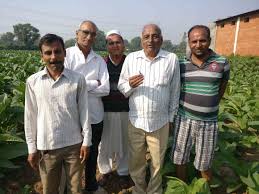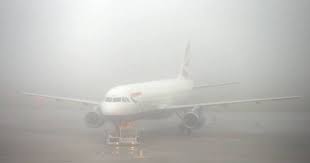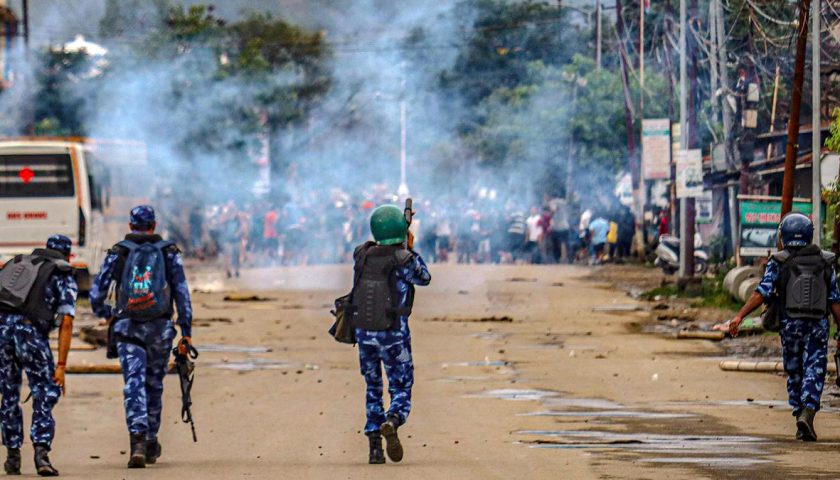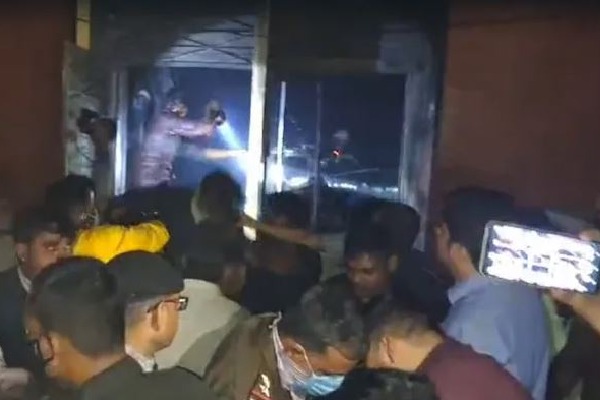A worsening agrarian crisis and rising unemployment has morphed into concrete political anger against the BJP – a matter that the party hasn’t addressed in its election campaign.
Ahmedabad: The first phase of Gujarat polls is over. People in 89 seats from 19 districts in Saurashtra, Kutch and south Gujarat have already voted. It was then that Prime Minister Narendra Modi asserted – albeit without any proof – that some retired army officials of Pakistan were lobbying to make Ahmed Patel the chief minister of Gujarat if the Congress wins. While this allegation is a serious one, one may wonder what is wrong with Ahmed Patel becoming chief minister. He is, after all, a senior politician with many years of experience.
Keeping with the BJP’s overt Hindutva campaign in the last lap of polls, Modi deemed fit to evoke the worst communal insecurities among Hindus – who have been fed enough anti-Muslim rhetoric in the last two decades – with the possibility of a Muslim becoming the chief minister of the state. However, by doing so, he has masterfully deflected from the two most significant issues – a worsening agrarian crisis and unemployment. These are matters that the BJP, even in its rhetoric about development, hasn’t dealt with at all in its canvassing, probably out of fear that they may backfire against the party’s electoral prospects.
Villagers across caste and community alliances vented out their anger against the failure of successive governments – both in the state and the centre – to address the problem of rising production costs and declining rate of returns in Gujarat’s cash-crop dependent agrarian economy.
Similarly, across the state, young educated men and women – who make around one-third of the state’s voting population, a majority of them with agrarian backgrounds – want the political class to create more jobs, preferably in public sector units. For instance, the much-talked about Patidar agitation, which started with a demand for reservation, has now transformed into what an article in the Hindustan Times called “a strong demographic demand for state-aided education and jobs.”
Farming crisis
How did the gradual unfolding of a farming crisis morph into concrete political anger? Stakeholders in the agrarian economy blame it on a combination of factors like declining farm incomes, the lack of government support, and a sharp drop in property prices over the last few years. All of these culminated into what the many villagers called “a double-speak of the BJP government”.
An average farmer in Gujarat has around five acres of land, a large chunk of which is owned by Darbars (Rajputs) and Patidars. Many of them profited from good monsoon spells, a booming global market for cash crops, and investments in land until 2012, a period that lasted for about ten years.
However, the current scenario presents a gloomy picture. The three stakeholders in the agricultural trade – farmers, commission agents and buyers – have been badly hit by multiple factors.
Farmers complained about the lack of remuneration in farming, which is why their children have started looking to other sources for jobs. Lack of adequate irrigation and power supply, increasing production costs and a demand crunch has sent shock waves in the state’s agriculture-driven rural economy.
“Water is our biggest problem. There is no planned irrigation in most parts of Gujarat. We were hopeful that the Sardar Sarovar Dam on Narmada river would solve this problem. But until now, we are dependent entirely on boring pumps. We get water only after digging 1500 feet below. The government has not built the promised canal network in most villages of this area,” said Gunwant Bhai Patel, adding that he had to share one-third of his cumin and castor seed crop with the trader who invested (around Rs 20 lakh) in a common boring pump in Gaglasan village in Patan district of north Gujarat.
“We have not saved a penny since 2012. In fact, we have suffered losses,” he said.
“Before 2012, we used to get Rs 1,200 per mann (20 kg) for cotton. Then our chief minister Modi ji protested against the central government to demand that we should get at least Rs 1,600. But since the last two years, the maximum we have received is Rs 700, and Modi ji, who is now our prime minister, hasn’t uttered a word on this,” said Vinod Bhai Patel, a cotton farmer near Mehsana. Speaking about the losses, he said that in order to produce 20 kg of cotton, most farmers spend anywhere between Rs 600-800, depending on the amount of fertilisers and pesticides they use.
The situation in Saurashtra and central Gujarat is similar.
“The cost of fertilisers and pesticides has increased manifold after the implementation of GST,” said Jagdish Bhai Patel in Amreli, which also houses the biggest mandi in the region for groundnut and cotton.
He added that the cost of production has doubled after the implementation of GST. “The government never came to procure our crop. But now due to the elections, Vijay Rupani (Gujarat’s chief minister) announced that the government would buy groundnut and cotton. But he also made a rule that only 50 farmers will be able to directly sell their produce to the government. At least 2000 farmers come to the mandi every day. This rule has meant that only those who are close to the market authorities get to sell their crop directly whereas most go through commission agents, losing a substantial chunk of their incomes in the process,” he added.
Cotton farmers have particularly been facing losses due to the dip in demand as a result of disruption in the functioning of textile mills after the implementation of GST. Groundnut farmers (who sold their crop for Rs 1,200 until 2012 but are now selling at a maximum of Rs 700 per mann), on the other hand, are just getting by as the demand from the edible oil industry, despite reducing, is relatively stable.
What this means is that none of the farmers depend anymore on a single crop, and have instead gone for multiple cropping. However, diversification has saved a majority of small and medium farmers from market vagaries but has also left them without much savings.
Similarly, tobacco growers in districts like Kheda, Anand and Vadodara in central Gujarat are facing a different set of problems. GST has affected this section of farmers the most.
“The GST rate for tobacco is 28% now. The traders are facing a huge demand crunch as the market is still coming to terms with the new rules and regulations. The big farmers can stock the crop for another two or three years but small farmers like me cannot do that as I need cash to sustain. The traders have halved the rates in the last one month. This is the peak selling season. I sold my crop for Rs 500 per mann only yesterday. Last year, I had sold it for Rs 1500,” said Sandeep Desai, a farmer leader in Anand, adding that if the government wants to discourage tobacco farming, they should first create alternatives for farmers in the region.
Disruption in the payment cycle due to GST
Commission agents and buyers of the crop are in no better condition.
Most of these agents rely less on their commission (around 1-5% which they get from the buyer) and more on the interest they accrue from lending input to farmers. Each agent is intricately linked – both socially and economically – to hundreds of farmers. In order to keep this network intact, the farmer usually goes to his moneylender to get his crop sold in the mandi.
The agent deals with a complicated cycle of payments. “The buyer usually takes around six months to make the payment. We sell on credit. But we pay the farmer immediately as he needs the cash to survive. Following demonetisation, we couldn’t pay the farmer on time. And now GST has completely destabilised our business cycle. Most buyers have told us that they won’t be able to pay us on time. Should the trader and agent leave their businesses and keep filing tax returns? We want the process to be a little flexible, a little easier,” Yogendra Jadeja, an agent in the Deesa mandi in Banaskantha district told The Wire.
“Earlier, to have an office in the Deesa mandi (the biggest paddy market in north Gujarat) would have cost more than a crore. But an agent sold his office at Rs 50 lakh only yesterday. The agent is neither being able to recover his loan from the farmer nor is getting timely payments from traders. In Deesa alone, at least four agents have committed suicide in the last one year,” Jadeja said.
Most of the mandi’s paddy directly goes to the rice mills but a complicated GST procedure has shrunk the demand from mills. “Our orders have gone down by at least 60% in the last few months. On top of this, the multiple GST slabs have only worsened the business. For instance, if we pack the crop to transport it to the mills, we would have to pay 5% GST on packaged items. The buyer doesn’t want packed goods and is also not ready to receive the paddy crop loose. In the mandi, we are the only one answerable to both farmers and traders. What should we do?,” he questioned.
The traders or buyers of the farmers’ produce, too, blame an inflexible GST for their failing businesses. “We used to sell the cash crops procured from the mandis in the global market. Tobacco, castor seeds, groundnut and many other such crops were bought by big industries in India or outside. The cascading effects of global recession hit us really bad. The demand went down to an all-time low. And around a year back when the market was showing some growth again, GST came as a blow. People are still figuring out how to deal with it. The government changes the rates every now and then. This has disrupted the payments cycle at every stage of the trade,” said Dinesh Shah, a wholesale trader who deals with tobacco and groundnut in Kheda.
Crash in property rates
Most people involved in agriculture in the state used their profits to buy properties across rural India in the last decade. The corporate-led growth pursued by the state government, popularly known as the Gujarat model, led to a huge demand for land. Aided by various infrastructural incentives by the state government, industries bought land at attractive rates from people.
“The affluent ones in the agrarian sector saw an opportunity to buy cheap land – in mostly cash transactions – and later sell it to different industries that mushroomed in the last decade. But this export-oriented growth stagnated after the global recession, and so did the property prices. The returns on investments in land suddenly reduced and the properties became a liability. This brought the community’s focus back to agriculture, only to find it in a state of crisis,” said Hetal Patel, a small trader in Ahmedabad who also works as a manager of a tile factory in Morbi.
He added that most affluent Patidars and Darbars suffered huge losses in the real estate market. “With their businesses dying because of harsh policies now, they are investing huge sums of their savings on the stock market. The stock market is keeping their hopes afloat. But one can only see their desperation while they try to latch on to their lost glory,” he said.
Demand for economic security
This deepening crisis has led to a huge craving for jobs among the youth of rural Gujarat. The educated youth does not want low-paid jobs in the informal sector, which has been suffering, but in government institutions which offer security and fixed incomes. A deep sense of this economic insecurity is being articulated by the youth in multiple ways, some of them being a demand for reservation or ending the privately-governed higher education system.
Indeed, it was a gradual reversal of fortunes for people in the agrarian sector that appeared to be precipitating an unprecedented anger against the state government, which they thought was turning a blind eye to their problems.
Explaining the transitions in agriculture, economist Itishree Pattnaik, who has worked extensively on the subject, wrote in one of her papers that factors like a boom in high-yielding seeds like Bt-cotton cultivation, favourable monsoons, state-aided power sector reforms and scientific farming boosted agriculture in the state but unfavourable monsoons and a volatile market since 2010 has proved to calamitous for the sector.
“The growth rate has collapsed in the recent period and it was as low as 3.7% during the period 2003-04 to 2015-16… even the positive growth of livestock economy couldn’t help much. The production of major crops like cotton, groundnut and maize has dropped, particularly after 2010-11, and the yield of cotton and groundnut has remained stagnant,” Pattnaik said.
“The increasing distress of agrarian sector is due to the lower growth in income of farmers, after 2011-12 the growth rate of farmer’s income was only 1%. The present government’s decision to double farmer’s income by 2022, came in the middle of the agrarian crisis, which might be a huge challenge to achieve. Among the 18 major states, income from crop cultivation in Gujarat ranks 11, which is below the national average (Situation Assessment Survey-NSSO 2014),” she added.
She points out in one of her unpublished papers that “around 43% of the farm households are indebted in Gujarat and a major chunk of farmers, as reported by NSSO, do not like farming as a profession. They are stuck to farm due to lack of other income earning opportunities.”
The non-profitability in the sector is for everyone to see, yet, it remains conspicuous in its absence from Modi’s series of speeches. Former Gujarat chief minister Suresh Mehta told The Wire in an interview that agricultural subsidies declined from Rs 195 crore in 2006-07 and Rs 408 crore in 2007-08 to only Rs 80 crore (revised estimates) in 2016-17. In the same period, he said, subsidies given to the big corporates-driven energy and petrochemicals sector increased from Rs 1,873 crore to Rs 4,471 crore.
The government’s indifference has affected more than half of the state’s population that majorly relies on farm incomes. When the prime minister prioritises polarising issues in his speeches over a structural crisis, tough questions are bound to be asked.






